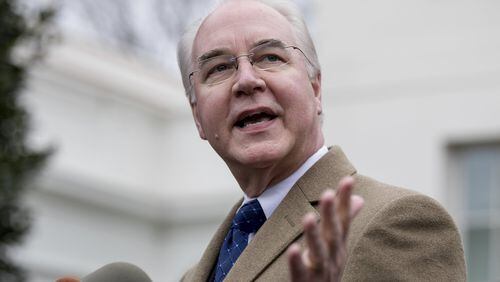Republicans supporting the House GOP’s effort to repeal and replace Obamacare are pushing back on criticism that the plan would strip health insurance away from an estimated 6 million to 15 million Americans.
In comments on the Sunday shows March 12, surrogates for President Donald Trump drew a distinction between being insured and being able to access affordable health care.
Health and Human Services secretary Tom Price, a former Cobb County Republican congressman, also made the case that the number of new people insured as a result of Obamacare can be overstated.
“The number of individuals who actually got coverage through the exchange who didn’t have coverage before, or who weren’t eligible for Medicaid before is relatively small,” Price said on Meet the Press. “So we’ve turned things upside down completely for 3 million, or 4 million, or 5 million individuals.”
Is that correct?
The passage of the Affordable Care Act, or Obamacare, did result in a spate of Medicaid enrollees who were previously eligible for the program (about 3.2 million). But beyond that, Price’s claim falls apart.
3 million to 5 million new enrollees? No
Price focused on two pools of people — those who benefited from the plan to expand Medicaid and uninsured Americans who purchased coverage through a federal or state exchange or marketplace.
Through that lens, Price’s figures are off.
Nonpartisan health care analysts at the Kaiser Family Foundation have concluded that, as of March 2016, more than 11 million Americans have gained access to health care as part of the Medicaid expansion. As we noted, an additional 3.2 million Americans signed up for Medicaid but were previously eligible.
Finding data on the number of previously uninsured people who signed up for care through a health care exchange is more challenging. But the numbers that do exist further undercut Price.
In 2015, researchers at the nonpartisan RAND Corporation estimated that 4.1 million previously uninsured Americans had gained access through a health care exchange or marketplace.
That’s roughly 15 million Americans who weren’t insured who now are, which is three to five times the number Price used.
Sherry A. Glied, dean of the Robert F. Wagner School of Public Service at New York University, recently examined how much of a factor the Affordable Care Act is playing in cutting the uninsured rate.
Looking at the Affordable Care Act’s first open enrollment period (2013-14), Glied concluded that the health care law explained about 76 percent of the decline in the uninsured rate. Glied told us that translates to 9.8 million more people covered as a result of the health care law’s policies in 2014.
“Since then, the uninsurance rate has dropped further,” Glied said, which would mean the pool of people covered because of Affordable Care Act policies has grown.
That Medicaid expansion figure could be bigger
It’s important to note that the health care law actually was designed so that even more people would receive health care through the Medicaid expansion.
Historically, Medicaid coverage had been focused primarily on pregnant women, children and the disabled. Under the Affordable Care Act, eligibility was to be expanded to nearly all individuals under age 65 with incomes up to 138 percent of the federal poverty level. As part of the law, the federal government agreed to cover 100 percent of the cost of newly eligible people through 2016, 95 percent in 2017, 94 percent in 2018, 93 percent in 2019, and 90 percent in 2020 and beyond.
The original plan was that every state would expand the program, but a 2012 Supreme Court decision allowed each state to decide for itself.
To date, 19 states have refused to expand Medicaid eligibility — creating a gap in coverage.
How big is the gap?
Kaiser estimates an additional 2.5 million people were intended to get health care as part of the Affordable Care Act but have not.
What Price didn’t mention about the ACA
The Affordable Care Act included another provision to cover people who previously might be uninsured. The Department of Health and Human Services estimated in 2016 that 2.3 million young adults gained health care from 2010 to October 2013 as a result of a provision of the law that allows people under age 26 to stay on a parent’s plan.
The House GOP proposal retains that specific provision.
Our ruling
Price said, “The number of individuals who actually got coverage through the exchange who didn’t have coverage before, or who weren’t eligible for Medicaid before is relatively small. So we’ve turned things upside down completely for 3 million, or 4 million, or 5 million individuals.”
Price is understating the impact of the law on providing health insurance to the previously uninsured. The proposal to expand Medicaid alone has provided health insurance to more than 11 million Americans.
We rate this statement False.







